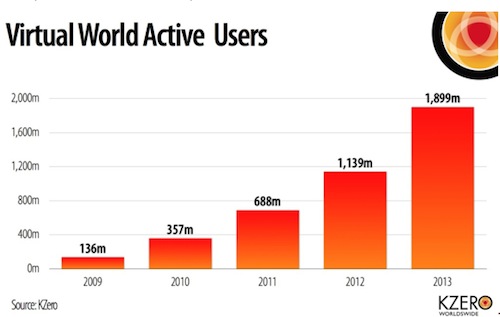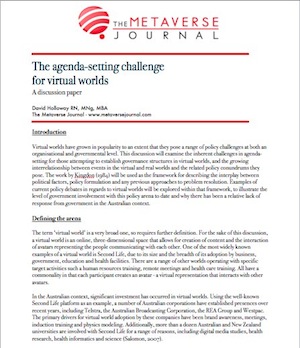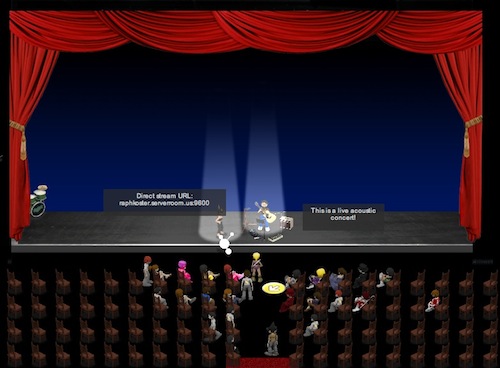1. The Guardian (UK) – Why playing in the virtual world has an awful lot to teach children. “What does playing computer games do to us? A YouGov poll has stirred up familiar worries about the effects of new media on children’s communication skills, saying that one in six children under the age of seven in England has difficulty talking – a problem that will have many worried parents looking at games consoles and wondering how far their children’s onscreen delights are implicated in this decline. Anyone who has played video games, or watched their children playing, will know that they are an exceptionally compelling medium. As Jean Gross, the government’s new communication champion for children, noted, overbusy parents can spend dangerously little time talking to their children. Far easier to plonk them down in front of a mesmerising screen.”
2. Virtual Worlds News (USA) – Data Provides Insight into Virtual Worlds, Goods Business Models. “Three data points released this week — which on their face didn’t appear to offer a boatload of value for individuals or companies with a stake in the virtual worlds and virtual goods industries — can be parsed for insight into how the markets are responding to some existing virtual world/virtual goods products, as well as how markets might be anticipated to respond to future business initiatives.”
3. Gadget (South Africa) – CES 2010: How kids play today… in the real and virtual world. “The line between the way children play in the real world and connect in the virtual world is becoming more and more blurred; this is according to the Build-A-Bear Workshop which extends its social interaction from the physical store through to the virtual world. Build-A-Bear Workshop, the interactive entertainment retailer of customised stuffed animals, announced new data that supports an evolution in how kids play and connect in their real and virtual worlds.”
4. Metro (UK) – The augmented reality helicopter drone you pilot with your iPhone. “The Parrot AR.Drone – a four-bladed ‘quadricopter’ with a range of 50m (165ft) – features two tiny video cameras which send real-time pictures to the phone’s screen, so you see what it sees. Interactive ‘enemy’ fighter planes are then layered over your view of your neighbourhood, using technology known as Augmented Reality. It takes current applications, such as superimposing photos on to Google maps’ satellite images, to another level.”
5. The National Law Journal (USA) – Social media permeate the employment life cycle. “Social media are any type of Internet-based media created through social interaction in which individuals primarily produce, rather than consume, the content. In the workplace, the prevalent social media are video-sharing Web sites (YouTube), social networking Web sites (Facebook, MySpace, LinkedIn, Twitter), online multiuser virtual worlds (Second Life, World of War craft) and personal or corporate blogs. The increased use of social media in the workplace, by employees and employers alike, presents both opportunities and risks for employers because social media now permeate the entire life cycle of employment: during pre-employment inquiries, throughout the period of employment and after separation from employment. Employers must consider and address the use and misuse of social media at each stage.”
6. Kelowna (Canada) – Virtual meetings come cheap; Thought delivery. “Virtual reality is a growing technology in Canada that small businesses can use to cut travel costs and expand markets because its immersive nature allows training and networking to be done in ways teleconferencing can not match. Mingleverse, a Vancouverbased virtual reality provider, is seeing a burst of consulting businesses looking to offer their services to a larger market, said Daniel Ruscigno, marketing co-ordinator. “We really expect online teaching, training and coaching to take off.” Launched in September, the company offers an experience similar to Second Life but with less downloading, Mr. Ruscigno said. Rather than one big virtual world there are several small virtual worlds you can embed in a website, he said.”
7. New York Times (USA) – The Children of Cyberspace: Old Fogies by Their 20s. “My 2-year-old daughter surprised me recently with two words: “Daddy’s book.†She was holding my Kindle electronic reader. Here is a child only beginning to talk, revealing that the seeds of the next generation gap have already been planted. She has identified the Kindle as a substitute for words printed on physical pages. I own the device and am still not completely sold on the idea. My daughter’s worldview and life will be shaped in very deliberate ways by technologies like the Kindle and the new magical high-tech gadgets coming out this year — Google’s Nexus One phone and Apple’s impending tablet among them. She’ll know nothing other than a world with digital books, Skype video chats with faraway relatives, and toddler-friendly video games on the iPhone. She’ll see the world a lot differently from her parents.”
8. Internet Evolution (USA) – The Internet in 2020: A Look Ahead. “Now that we’ve closed the book on the first decade of the 21st century, the real question is, What radically new Internet technologies will we be celebrating at the beginning of the century’s second decade? Ironically, imagining 2020 is really the business of the historian rather than the futurist. As David Edgerton argues in his brilliant 2006 book, The Shock of the Old: Technology and Global History Since 1900, the most radical new technologies are recycled from the past. To look forward, therefore, Edgerton suggests that we look backwards.”
9. AFP (USA) – Lego expands its universe with online game. “Danish toy maker Lego is seeking to build a presence in the world of multiplayer online games with the release of a new videogame called Lego Universe. “Think World of Warcraft, Second Life and Club Penguin all wrapped into one,” said lead producer Chris Sherland of NetDevil, the Colorado-based game development company behind Lego Universe. The PC-based game will incorporate many of the features of the iconic interlocking, studded plastic bricks that have delighted children — and parents — the world over for years. Lego Universe, which is to be released in the second half of the year, was unveiled at the annual International Consumer Electronics Show (CES) in Las Vegas which closes on Sunday.”
10. PC Pro (UK) – Whatever happened to Second Life? “It’s desolate, dirty, and sex is outcast to a separate island. Barry Collins returns to Second Life to find out what went wrong, and why it’s raking in more cash than ever before. Three years ago, I underwent one of the most eye-opening experiences of my life – and I barely even left the office. I spent a week virtually living and breathing inside Second Life: the massively multiplayer online world that contains everything from lottery games to libraries, penthouses to pubs, skyscrapers to surrogacy clinics.”





Recent Comments